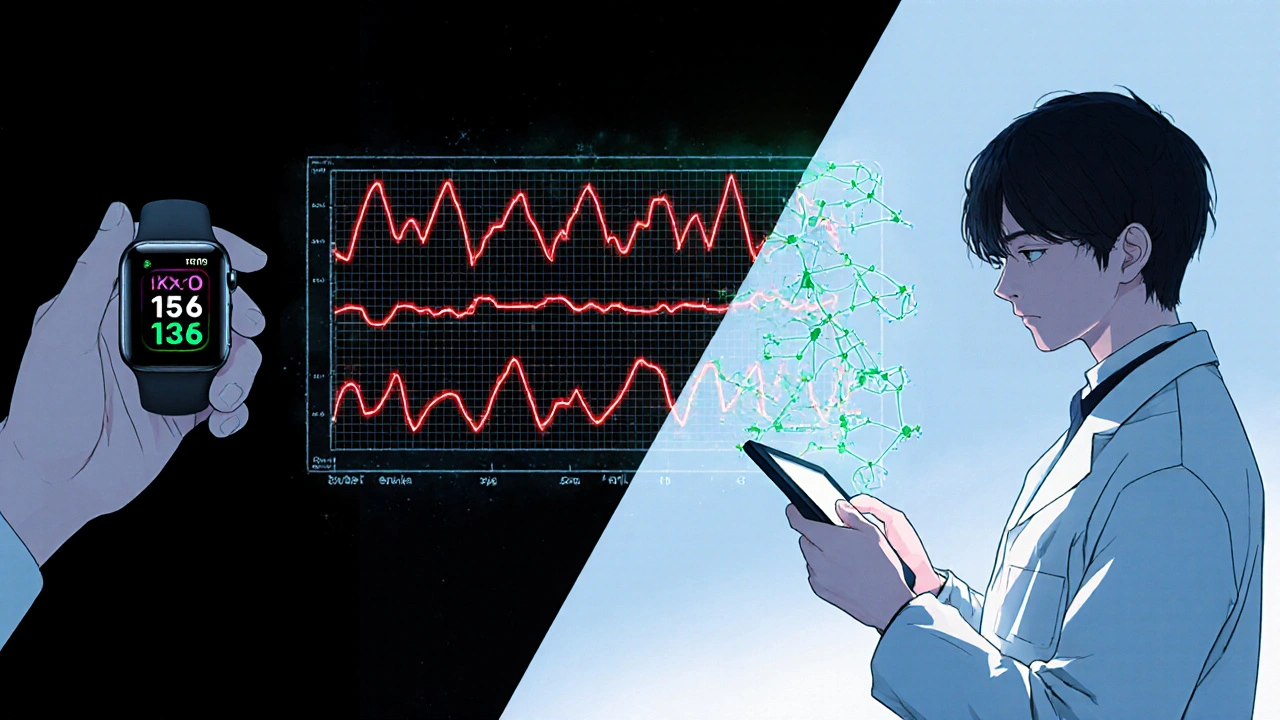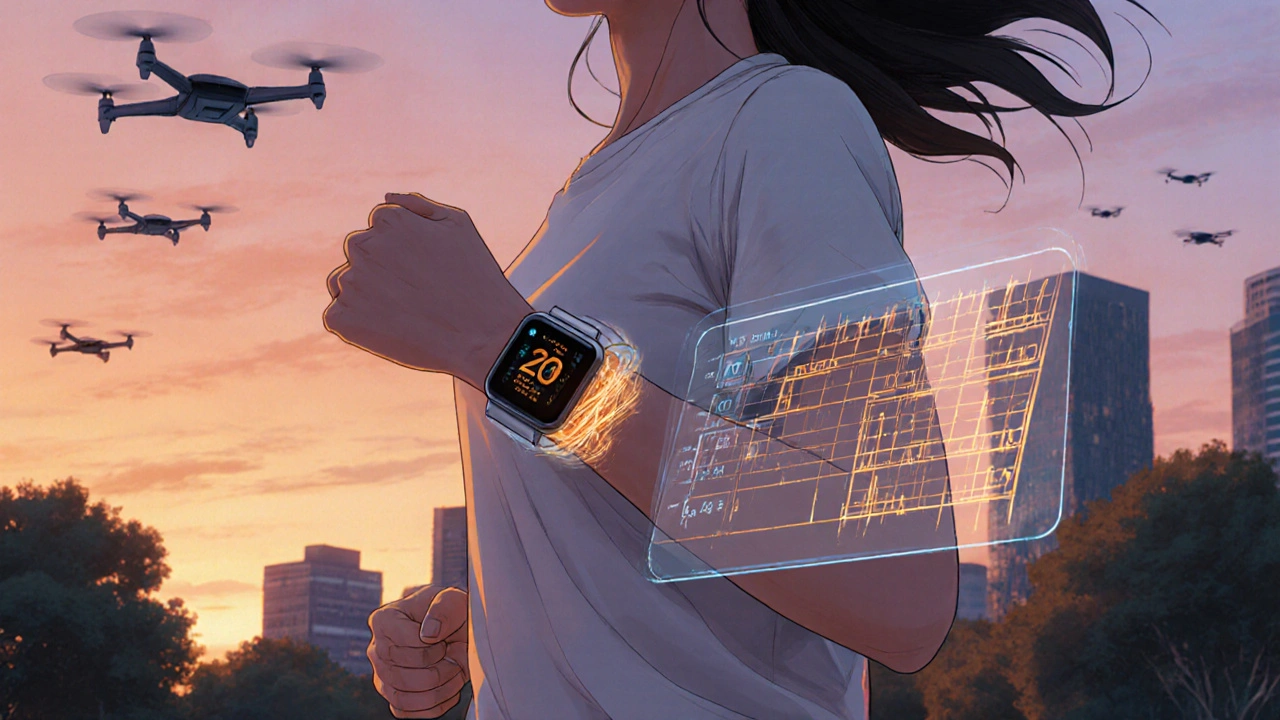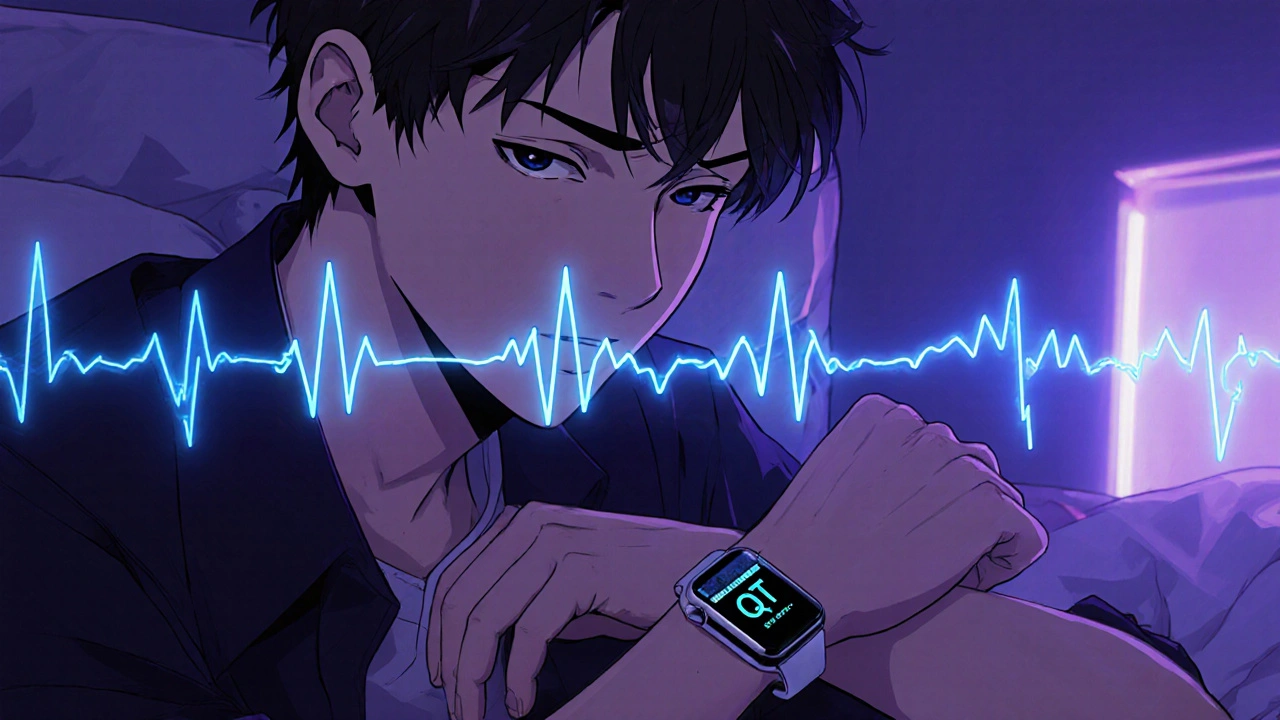QTc Interval Calculator
Calculate Corrected QT Interval
Enter the measured QT interval and heart rate to calculate the corrected QTc interval using standard formulas.
When a medication can stretch the heart’s electrical timeline, the stakes are high-sudden cardiac death or torsades de pointes can strike in minutes. clinicians need a way to watch the QT interval around the clock, not just during a 10‑minute office visit. wearable ECG devices now make that possible, turning a smartwatch or pocket‑size recorder into a real‑time cardiac safety guard.
Understanding the QT Interval and Its Risks
QT interval is the time from the start of the Q wave to the end of the T wave on an electrocardiogram. It reflects how long the ventricles take to repolarize after each beat. A prolonged QT (often reported as QTc after correction for heart rate) raises the chance of torsades de pointes, a dangerous ventricular tachycardia that can degenerate into sudden cardiac arrest.
Drugs such as certain antibiotics, antipsychotics, and antiarrhythmics are known to lengthen QTc. During the COVID‑19 surge, clinicians were forced to give hydroxychloroquine and azithromycin-both QT‑prolonging agents-while patients were isolated at home. That crisis sparked the first wave of remote QT monitoring research.
How Wearable ECGs Capture the QT Interval
Traditional 12‑lead ECGs remain the gold standard, but they require a clinic visit and a technician. Wearable ECGs simplify the process by recording single‑lead or multi‑lead traces through skin‑contact electrodes and sending the data to a smartphone for analysis. The device creates a brief circuit-thumb on a crown, fingers on electrodes, or thumbs plus a knee contact-producing a waveform that software can measure.
Two correction formulas dominate the field: Bazett’s and Fridericia’s. Modern algorithms automatically apply these formulas, outputting a corrected QTc value in real time. When a QTc exceeds a pre‑set safety threshold (often 500 ms), the system can trigger an alert to the patient, caregiver, or trial monitor.
Leading Devices and Their Validation
Apple Watch (Series 4 and newer) introduced an FDA‑cleared ECG app in 2018. A 2021 study by Spaccarotella et al. showed strong correlation with 12‑lead ECGs-Spearman’s r up to 0.914 for QT mean. The watch records a 30‑second Lead‑I trace when the user places a finger on the digital crown.
KardiaMobile 6L from AliveCor captures six leads (I, II, III, aVR, aVL, aVF) by having the user press thumbs on the top electrodes and the left knee or ankle on the bottom. Validation studies report QT measurements within ±20 ms of standard ECGs, matching the accuracy of a full 12‑lead setup for most correction formulas.
The FDA issued guidance in April 2020 explicitly allowing both devices for QT monitoring in COVID‑19 patients, marking the first regulatory nod for consumer‑grade QT measurement.
| Feature | Apple Watch (Series 4+) | KardiaMobile 6L |
|---|---|---|
| Lead configuration | Single‑lead (Lead I) | Six‑lead (I, II, III, aVR, aVL, aVF) |
| Recording time | 30 seconds | 30 seconds |
| QTc accuracy (vs. 12‑lead) | ±20 ms, r = 0.886-0.914 | ±20 ms, comparable to 12‑lead |
| FDA status (2023) | Cleared for ECG & rhythm detection | Cleared for QTc measurement & AF detection |
| Patient workflow | Finger on crown, wrist worn | Thumbs + knee/ankle contact |
| Data transmission | Bluetooth to iPhone | Bluetooth to iOS/Android app |

Artificial Intelligence: Automating QT Detection
Manual review of each trace defeats the purpose of continuous monitoring. Alam et al. (2024) built a Residual Neural Network that ingests two ECG beats from Lead‑I and Lead‑II, then predicts whether QTc exceeds 500 ms. Tested on 686 patients with genetic heart disease, the model achieved >90 % sensitivity and >85 % specificity, matching expert cardiologists.
These AI engines can run on the phone, providing instant risk scores without sending raw waveforms to the cloud-critical for privacy‑sensitive trials.
Clinical Use Cases and Regulatory Landscape
Case reports from the early pandemic (Chinitz 2020) described patients on hydroxychloroquine whose QTc spikes were caught by an Apple Watch, prompting dose adjustment before an arrhythmia occurred. Since then, pharmaceutical sponsors have incorporated wearables into Phase I‑III trials to meet FDA cardiac safety requirements. The FDA’s 2020 guidance still serves as the regulatory backbone, urging sponsors to document device validation, skin‑to‑electrode impedance handling, and patient training.
Real‑world evidence from Applied Clinical Trials (2023) shows that continuous wearable data reduces missed transient QT spikes compared with intermittent Holter monitoring, shortens trial timelines, and cuts costs by up to 15 %.
Implementing Wearable ECG Monitoring in Practice
Successful rollout hinges on three pillars: device selection, patient education, and data workflow.
- Device selection: Choose FDA‑cleared devices with published QT validation. Apple Watch is ideal for patients already in the Apple ecosystem; KardiaMobile 6L suits multi‑lead needs and offers broader signal fidelity.
- Patient education: Demonstrate proper electrode placement. For the Apple Watch, the user must keep a finger on the digital crown for a full 30 seconds; for KardiaMobile 6L, thumbs on the top electrodes and the left knee/ankle on the bottom. Provide video guides and a printed checklist.
- Data workflow: Use a secure, HIPAA‑compliant app that streams QTc values to a central dashboard. Set alert thresholds (e.g., QTc > 500 ms) to notify clinicians via SMS or email. Integrate the dashboard with the trial’s electronic data capture (EDC) system for audit trails.

Benefits and Limitations
Benefits include real‑time detection of sudden QTc prolongation, reduced patient visits, and richer safety datasets for regulators. Limitations remain: skin‑to‑electrode impedance can degrade signal quality, especially in sweaty or dry skin; single‑lead devices may miss vector‑specific abnormalities; and most consumer wearables lack a dedicated QTc algorithm, relying on third‑party software.
Clinicians should treat wearable readings as a screening tool-positive alerts still need confirmation by a standard 12‑lead ECG.
Practical Checklist for QT Safety Monitoring
- Verify FDA clearance for QT measurement.
- Confirm device accuracy meets ±20 ms against a 12‑lead ECG.
- Train patients on correct electrode placement and recording duration.
- Set clear QTc alert thresholds (e.g., 500 ms for high‑risk drugs).
- Implement secure data transmission and storage (HIPAA‑compliant).
- Schedule periodic confirmatory ECGs in clinic.
- Document all alerts and actions in the patient record.
Future Outlook
Within the next five years, multi‑lead smartwatches and AI‑enhanced analytics are expected to close the gap with hospital‑grade ECGs. Ongoing research aims to embed sensors in clothing and rings, expanding monitoring beyond the wrist. As regulatory frameworks evolve, we’ll likely see FDA guidance specifically addressing AI‑derived QTc measurements, paving the way for fully autonomous, at‑home cardiac safety trials.
Can a consumer smartwatch replace a 12‑lead ECG for QT monitoring?
Smartwatches provide a reliable QTc estimate within ±20 ms for most patients, but they lack the full vector information of a 12‑lead ECG. Use them for screening and early warning; confirm any abnormal reading with a clinical ECG.
What QTc threshold should trigger an alert?
Most guidelines flag QTc > 500 ms as high risk, especially when patients are on multiple QT‑prolonging drugs. Some trials use a lower trigger (≥ 460 ms) for women or patients with congenital long QT syndrome.
Is an FDA clearance enough to use a device in a clinical trial?
Clearance is a prerequisite, but sponsors must also provide validation data specific to the trial’s population, document training procedures, and ensure data security compliance with the trial’s protocol.
How does AI improve QT detection on wearables?
AI models can denoise raw waveforms, automatically select the best leads, and calculate corrected QTc within seconds. They also flag borderline cases, reducing the need for a clinician to review every recording.
What are common pitfalls when using wearables for QT monitoring?
Poor skin contact, rapid motion, and using the wrong lead can distort the waveform. Patients must follow exact placement instructions, and clinicians should verify signal quality before trusting the QTc reading.


Jennie Smith
October 25, 2025 AT 17:29Wow, the world of real‑time QT monitoring is finally getting the rainbow‑colored boost it deserves! 🌈 Wearable ECGs are like tiny superheroes slipping on our wrists, ready to zap dangerous arrhythmias before they even think about crashing the party. I love how the Apple Watch turns a casual glance at the time into a life‑saving glance at the heart. And the KardiaMobile 6L? It’s practically a pocket‑sized orchestra, playing six leads in perfect harmony. The integration of AI isn’t just cool tech-it’s a true guardian angel for patients on high‑risk meds. Let’s keep this momentum rolling, folks-education, accessibility, and a dash of creativity will make these devices the new standard of care!
Anurag Ranjan
October 25, 2025 AT 21:39The key is patient training Make sure they place the electrodes right and hold still The data then becomes reliable and clinicians can trust the alerts.
Greg Galivan
October 26, 2025 AT 01:49Its not rocket science wear a watch and check your QTc.
Edward Brown
October 26, 2025 AT 05:59While we cheer tech advances remember the unseen hands that guide data streams corporate giants and hidden algorithms watch every heartbeat they claim to protect yet they profit from our fear and reliance on devices that may be nudged by unseen firmware updates raising questions about true independence of the readings
James Doyle
October 26, 2025 AT 10:09In the contemporary landscape of electrophysiological surveillance, the deployment of consumer‑grade wearable telemetry systems represents a paradigm shift from episodic, in‑clinic diagnostics to a continuum of ambulatory data acquisition.
First, the methodological rigor inherent in the QTc correction algorithms-particularly the transition from Bazett’s to Fridericia’s formula-mitigates rate‑dependent confounders that historically plagued single‑point measurements.
Second, the fidelity of signal capture afforded by multi‑lead configurations, as exemplified by the KardiaMobile 6L, facilitates vectorial analysis, thereby approximating the diagnostic granularity of a conventional 12‑lead apparatus.
Third, the integration of convolutional neural network architectures for automated QT interval delineation reduces inter‑observer variability, a perennial source of bias in cardiology research.
Moreover, the latency reduction achieved through on‑device inference circumvents the privacy concerns associated with cloud‑based processing, aligning with contemporary GDPR‑compliant frameworks.
From a pharmacovigilance standpoint, continuous monitoring enables the detection of transient QTc excursions that would be otherwise missed in sporadic Holter recordings, thereby enhancing the signal‑to‑noise ratio in safety signal detection.
Regulatory bodies, notably the FDA, have signaled a permissive stance toward these technologies, provided that validation data demonstrate concordance within ±20 ms relative to gold‑standard electrocardiography.
Nevertheless, clinicians must remain vigilant regarding artefacts induced by dermal impedance fluctuations, motion artefacts, and suboptimal electrode contact, all of which can precipitate erroneous QTc extrapolations.
In practice, a tiered workflow-comprising initial wearable screening, confirmatory 12‑lead verification, and subsequent data integration into electronic case report forms-optimizes both safety oversight and operational efficiency.
Ultimately, the convergence of wearable biosensors, robust AI analytics, and regulatory endorsement heralds a new epoch wherein cardiac safety monitoring attains both scalability and precision, paving the way for decentralized clinical trial paradigms and personalized therapeutic stewardship.
ALBERT HENDERSHOT JR.
October 26, 2025 AT 14:19Excellent synthesis! Your detailed breakdown underscores how each component-from correction formulas to AI inference-interlocks to create a reliable safety net. It’s crucial we maintain rigorous validation protocols while embracing this innovation. Keep up the great work! :)
Suzanne Carawan
October 26, 2025 AT 18:29Oh sure, because a 30‑second thumb‑on‑crown reading is going to catch every dangerous spike. Next, we’ll trust smart toasters to diagnose heart disease.
Kala Rani
October 26, 2025 AT 22:39Maybe if the toasters had better leads and less noise you’d believe them but not
Octavia Clahar
October 27, 2025 AT 02:49Honestly, I’m thrilled that we finally have a tool that can flag QT issues before someone ends up in the ER. It feels like a safety net that actually works, and I think patients will appreciate the peace of mind.
Lionel du Plessis
October 27, 2025 AT 06:59cool but remember wearables need good skin contact and low motion for accurate reading otherwise you get junk data
Andrae Powel
October 27, 2025 AT 11:09I hear you both – the technology is promising, yet we must ensure robust training and clear protocols so patients feel confident using these devices. A balanced approach will maximize benefits while minimizing false alarms.
christine badilla
October 27, 2025 AT 15:19And then the moment the monitor beeps, I’m suddenly the star of a medical drama – “Will she survive the QT spike?” Spoiler: she lives, thanks to that magic smartwatch.